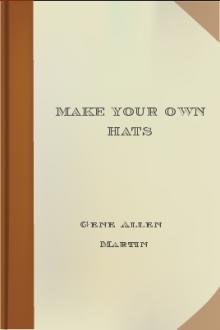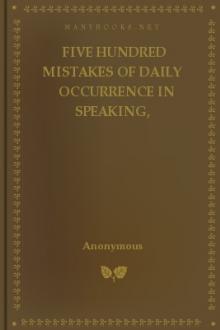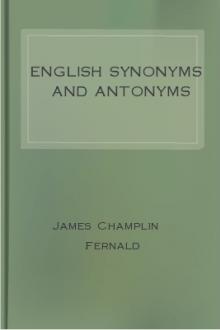Make Your Own Hats, Gene Allen Martin [ebook offline txt] 📗

- Author: Gene Allen Martin
- Performer: -
Book online «Make Your Own Hats, Gene Allen Martin [ebook offline txt] 📗». Author Gene Allen Martin
Sheer materials—
In covering with anything as sheer as georgette, it is advisable to line with some other material first. The color could be made deeper by using a lining of the same color, or made paler by lining with white. The lining should be fitted and sewed on with the outside material.
Pattern for hat with rolled or close-fitting brim—
The pattern for any hat is first cut from a flat piece of paper. The headsize is marked as for flat sailor and the headsize wire pinned on. The pattern is then slashed in to headsize wire from the outside edge, the slashes lapped over and pinned. If the hat is to be rolled more closely on one side than on the other, the greater number of slashes must be placed there. In this way the pattern can be adjusted to any desired shape. It is an advantage sometimes to cut the paper pattern through in the back, leaving pins in the slashes, and lay out flat on another piece of paper for a new pattern. This eliminates some of the slashes and makes further experiments easier. Pattern-making is very important, and it is of extreme value to make as many patterns as possible before cutting the foundation fabric. Changing a pattern the slightest sometimes makes a great deal of difference in its becomingness. Of course a brim may be changed by adding a slash or two in the buckram, or by inserting a V shape to give more flare, but the fewer seams the better for the hat frame. A rolled or close-fitting brim is more difficult to cover than a sailor or mushroom shape.
To cover a close-fitting or rolled brim—
Place corner of material on top of brim at front and pin on the edge. Always use the same method of pinning on the edge as given in the first lesson. Draw the material down to the headsize wire and pin. Work the material out smoothly toward the left and pin at the edge; also at the headsize wire. Then proceed in the same way toward the right, always pinning closely. Be sure to keep the material tight and smooth both at edge and at the headsize wire. Allow the fullness to go where it will. The seam should be located at the center back. Cut away all superfluous material, allowing three-eighths of an inch seam at the center back. Turn the raw edges under away from each other at the seam and slipstitch together neatly.
To slipstitch seam—
Bring needle through edge of fold on one side and enter the needle through edge of fold on other side exactly opposite. Slip needle along in this fold one-eighth of an inch, then bring the needle through to the edge of the fold and take a stitch one-eighth of an inch long in the fold of the other side, always being careful to begin the stitch exactly opposite the end of the one preceding. Try to cut the material out from inside the headsize wire in one piece so that it may be used for something else. Examine the material carefully to make sure that it fits perfectly. Baste with a stab stitch close to the headsize wire on the outside; remove all pins as soon as possible. After basting this, you will sometimes find that the material needs a little more adjusting at the edge. Turn the velvet over the edge one-fourth inch and sew down with an overcasting stitch.
To glue velvet to the brim—
When there is a decided roll to a brim, it is sometimes most difficult to keep the velvet smooth and to make it lie close to the brim, so we resort to milliner's glue. Do not use glue on satin, or on any fabric thinner than velvet, or on any frame other than buckram. Care should always be taken to have the smooth side of the buckram on top when the velvet is to be glued on.
After fitting the velvet carefully and sewing the seam in the back, remove the pins from the outer edge and gather the velvet up inside the headsize where it is to be held while the glue is being spread on the buckram. The glue must be spread very evenly. It will make a neater job to glue the seam of the velvet open before going further. Be very careful to keep the glue away from the right side of the velvet. Next, rub the glue on the frame with a stiff brush until it is smooth, then spread the velvet back into place, pressing and smoothing it with the hands from the headsize wire out. Watch it carefully for any places which have not sufficient glue, as the material may be raised before it is dry and more glue added. Do not sew the edge until the glue has dried. Usually it is only the material on the upper side of the brim which needs gluing down. The facing may be put on as desired. Sometimes the top of a crown has indentations, and then the velvet may be glued to stay in place.
The under or outer facing may be fitted to a rolled or close-fitting brim more easily than the upper. Beginning at the front with the corner of the material, pin at the edge and at the headsize wire. Keep the material smooth; work from right to left, and then from left to right. Work the material around to where the seam is to be made. Cut away all superfluous material, allowing three-eighths of an inch for a seam. Slipstitch together as on the top and finish the edge over wire. Whenever possible a seam should be made on the straight of the material.
A shirred crown of fabric—
There are two methods of making a shirred crown of fabric in which taffeta, satin, georgette, or velvet may be used. Velvet is especially beautiful made up in this way. The first method is the preferred. Cut a circular piece of material, having a diameter the length of the crown from front to back, measuring over the top from the headsize wire, plus four inches.
On the wrong side of the material mark circles (concentric) one-half inch apart, after first having marked a circle in the center about three inches in diameter. Gather on the line of each circle with a fine running stitch and bring the thread through to the right side as each circle is completed.
Locate the exact center of the crown top and cut a small hole at this point. Pull thread of the smallest circle up tight. This will form a bag which should be pulled down through the hole made at the center of the crown top and sewed securely in place. The material should be pinned down at four equal points at the edge of the crown, the threads of the other circles pulled up until the material fits the crown snugly. Adjust the fullness evenly and sew in place. This is an excellent way to use up old material which would otherwise show marks or any other defects.
The second method does not make as pleasing an effect, but may be used when the material happens to be in such shape that a circle cannot be cut from it. A bias strip about eight inches wide and long enough to reach around the crown, plus three or four inches, should be joined on the lengthwise thread of the material. The first shirring or gathering should be one-half inch from the edge, the additional threads should be run in evenly every half inch. The first thread near the edge should then be drawn up as tightly as possible and this edge pushed through the hole in the top of the crown. This method will require a somewhat larger opening than the first. The material is then drawn down on the outside and pinned to the bottom of the crown; the threads are then pulled tight and firm and are fastened off. Next adjust the gathers evenly and sew in place.
CHAPTER III FRAMES OF NETEEN AND CRINOLINELay the pattern on the neteen in such a way as to bring the bias where the greatest amount of roll is to be, then cut making the same allowances as if cut from buckram. This material should be used double to secure the best results. Cut one thickness first and pin this on another piece in such a way that the warp thread of one piece will lie parallel to the woof thread of the other. Cut the two pieces the same size and before removing the pins baste closely all over the brim with fine thread, making one inch stitches. Fine thread should be used for this as a coarse thread might show through the covering.
To join the seam in the back—
Insert one thickness between the other two ends, and backstitch closely. This method ought to make a fairly smooth seam. Cover the seam with a strip of crinoline to smooth it up.
To sew edge wire on neteen—
It is difficult to sew edge wire on neteen. A good result is obtained, however, by sewing the wire directly on the edge or by covering the edge first with crinoline and sewing the wire on it. Great care must be taken in handling neteen to preserve the shape, as it is very easily stretched and pulled out of shape while sewing on the edge wire. The same method is used in covering a neteen frame as with the buckram frame. The velvet, if velvet is used, can be glued on, but the material is so porous that it is not very satisfactory. Neteen and crinoline make excellent foundations for braid hats, as these materials are light in weight, soft, and pliable. They are also very satisfactory for children's hats.
To make a turban frame of neteen or crinoline—
Make the side crown from a bias fold of neteen or crinoline, the height desired, plus one inch. The length should be the headsize measurement plus one-half inch. This allows for a tiny flare next to the face which is usually more becoming. Join the ends of bias strips on the warp thread.
To wire turban flare—
Sew the headsize wire one inch from the bottom, being careful not to stretch or full the material. Cut another piece of brace wire one or two inches larger than headsize wire and sew on the raw edge at the bottom, stretching the fabric to fit if a flare is desired. A roll may be made by slightly fulling the fabric on to the wire, which must be smaller than for a flare. If the side of the crown is to be curved in slightly, this is easily done by taping the side about halfway between the top and the bottom, drawing the tape as tight as is necessary. Next pin the tape and sew in place. Sew another wire high enough above the tape to make the crown the required height. If the crown is to be flared a little at top, sew the wire inside and stretch the material as much as desired. If the top of the crown is to be drawn in, sew the wire on the outside, making the crown slightly smaller at the top. If sufficient material is allowed at the top the extra amount may be drawn up over a small circle of wire to make the crown top, but an extra piece cut for this purpose is more satisfactory. A smooth crown may be made from an





Comments (0)